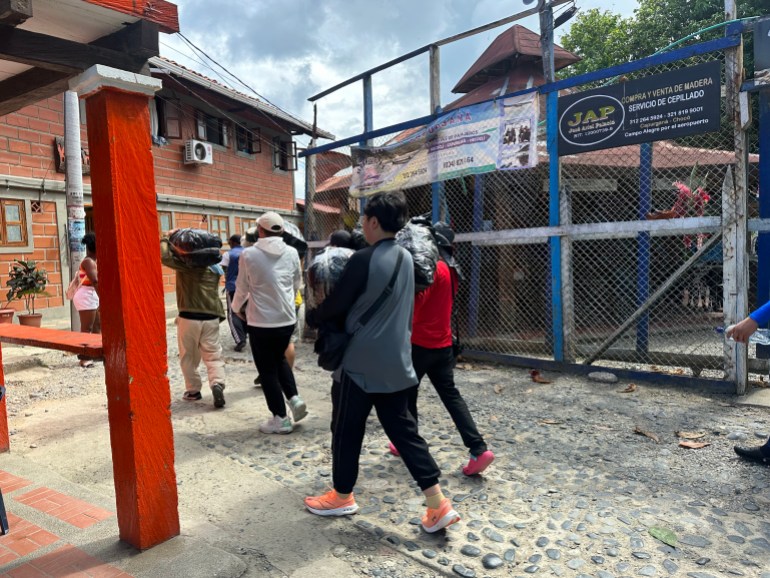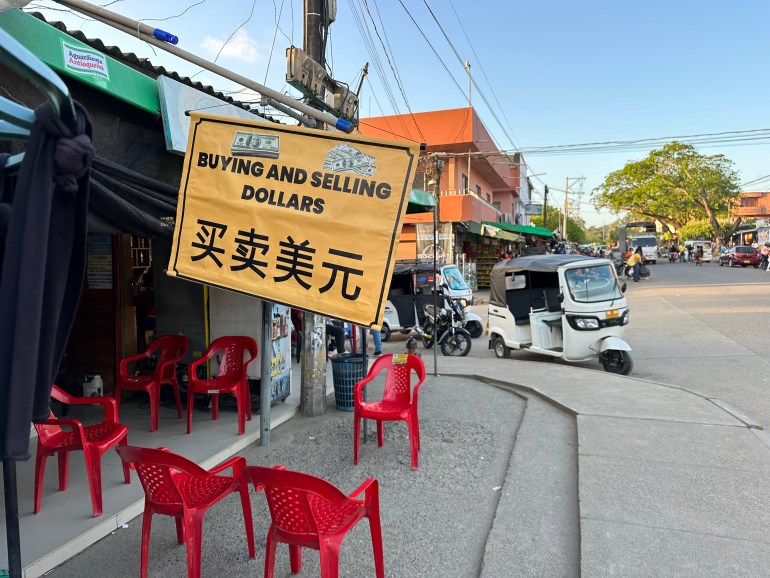Necocli, Colombia – Shortly after 8 a.m., about a dozen Chinese migrants burst from the doors of Mansion del Darien, a run-down hotel a few blocks from Colombia’s Caribbean coast, and pile into three tuk-tuks waiting on the street.
“We are full of Chinese people every day,” said receptionist Gabriela Fernandez, who scurried past the front desk with a clipboard in hand. “Large groups of them are constantly coming and going together. It’s been like this for months.”
Behind her are signs in Mandarin explaining the hotel’s rates and policies. Pots of spicy instant noodles imported from China are for sale alongside water bottles. Payments are accepted via Chinese social media app WeChat.
“They move in their own world,” Fernandez said.
The group of middle-aged travelers carrying hats, tents and hiking sticks are dressed for a hike. But not everything quite fits together. Many wear lightweight Crocs shoes and their small backpacks are packed in plastic bags.
Here in Necocli, a beach town near the Panama border, marks the starting point for crossing the Darien Gap, a region of dense and inhospitable jungle that has become a major migration route for those seeking to reach the United States.
According to the Panamanian government, more than 500,000 migrants crossed the treacherous Darien in 2023, the only overland route from South to North America. Just over 25,000 of those migrants were Chinese, making them the fourth largest nationality overall and the largest outside of the Americas to make the crossing.
“This is a new element that has not existed in previous years,” said Giuseppe Loprete, head of mission in Panama for the International Organization for Migration (IOM), a U.N. agency that provides information for migrants crossing the Darien. “There are a lot of people and it’s a long way. It’s big business for the smuggling networks.”
Chinese migrants, unlike many of the Darien’s most common nationalities, such as Venezuelans and Haitians, often take special “VIP” routes through the jungle that are run by leaders of the Gulf Clan, Colombia’s largest drug cartel, and are faster and less strenuous at higher prices than the easiest routes.
Through a combination of boat trips, hiking and, in some cases, horseback riding along the Caribbean or Pacific coast, they can complete the crossing in a few days, rather than the week-long journey typically required by cheaper routes.
Traffickers in Necocli told Al Jazeera that the cheapest routes over the Darien cost about $350, but the more direct routes along the Panamanian coast through towns like Carreto and Coetupo and arriving at one of Panama’s migrant reception centers cost $850. dollars cost.

But in some cases — trips to San Andres Island, just a few hours by boat from Nicaragua — the price can be as high as $5,000. It can bring the cartel tens of millions of dollars every month.
After all that spending, migrants must travel further north through the rest of Central America, battling corruption, theft and violence on their way to the U.S.-Mexico border.
“Why we want to go to the USA”
During a two-day visit to Necocli, Al Jazeera observed dozens of Chinese migrants preparing for the journey, including engineers, teachers and computer programmers.
Wu Xiaohua, 42, waiting on the beach with a friend to leave on a boat for Panama, said he chose one of these quicker trips because he was eager to get to the U.S. and get to work as quickly as possible would like to start. Originally from Hunan Province, Xiaohua moved to Shanghai to work as a taxi driver. But since the pandemic, life has been a struggle.
“There are major problems in our country’s economy,” he said. “We have no choice but to survive.” That’s why we want to go to the USA.”
“Our requirements are simple: we can afford medical treatment, have an apartment, our children can afford to go to school and our family can be safe.”
One migrant, Huang, who would only give her last name, said she left Beijing two months ago after China’s strict COVID-19 lockdowns ended her job as a masseuse and left her barely able to survive everyday life.
“I sold everything I had,” Huang said. “We were treated like caged animals.”

The huge increase in the number of Chinese making the journey across the Darien — a trip now so popular that it is known in Mandarin as “Zouxian,” or “walking the line” — has been fueled by the COVID-19 lockdowns the Chinese government, increasingly strict rules and the recent downturn in China’s once-powerful economy.
“This is due to political and economic uncertainties,” said Min Zhou, a professor of sociology and Asian American studies at the University of California, Los Angeles. “There was a downturn in the Chinese economy. People have become unemployed and there is dissatisfaction with the government’s strict policies.”
Ai Weiwei, a dissident artist and activist who fled China in 2015 due to repression, told Al Jazeera that the phenomenon was a sign of dwindling trust in the government.
“Normally, ordinary people in China are very reluctant to leave their homes,” he said. “This phenomenon of people suffering the agony of climbing through the rainforest while dragging their children with them is the first of its kind.”
“Chinese migrants are particularly at risk”
According to US Customs and Border Protection, more than 37,000 Chinese citizens were arrested for illegally crossing the US southern border in 2023. This number is almost ten times higher than in 2022 and more than double than the entire previous decade.
The journey from China can take months across multiple continents and cost up to tens of thousands of dollars. Many fly to Istanbul or Addis Ababa, where there are few logistical problems, and then to Ecuador, one of the few Latin American countries that allows Chinese nationals visa-free entry. From there, the dangerous and arduous journey to the Darien Mountains and finally to the USA takes place largely overland.
“Chinese migrants are particularly at risk,” Loprete said. “They are seen as wealthier and therefore can be targeted. The language problem also means it is harder for them to get medical help if something happens.”
During the journey, Chinese migrants are often exploited by smugglers, Loprete added. Beatings and robberies are also common on the lawless Panamanian side of the route.

The Chinese Embassy in Panama did not respond to questions about whether it supports its citizens in Darien, but said in an emailed statement to Al Jazeera: “China strongly opposes, opposes and actively participates in any form of illegal immigration activities international cooperation in this area.”
According to Zhou, who is conducting a research project on newly arrived Chinese migrants in Los Angeles, this wave of undocumented Chinese citizens is significantly different from the wave of migration in the 1980s and 1990s.
“They come from all over the country now,” Zhou said. “You are competent. Some are college graduates.”
Some migrants interviewed by Zhou were misled into believing they could easily get a job for $10,000 cash a month. However, the reality is that many find it difficult to find a job because employers are afraid to hire undocumented workers.
“The experience drives her crazy,” she said. “It gives them nightmares.”
Wang Sheng Sheng, a 49-year-old originally from western Qinghai province, said his decision to leave China was due to various reasons.
After working both as a teacher and in public relations in the city of Guangzhou, he said he felt “it has not been easy for me to speak freely” amid increasing crackdowns on university professors and independent organizations.
At the same time, Sheng, who has a 12-year-old son who lives with his ex-wife in China, believes that living in California could offer him better prospects for improving his living conditions, even if it means crossing the Darien, which is the case is requires climbing mountains, crossing mighty rivers and dodging armed bandits along the 115km route.
“I was forced to do this,” Sheng said as he sipped a cup of tea at his hotel in Necocli. “It is really difficult for most Chinese people to apply for a visa to America. But I’m disillusioned with China. That’s why we’re here in the jungle.”






Recent Comments